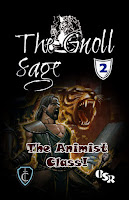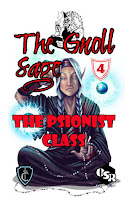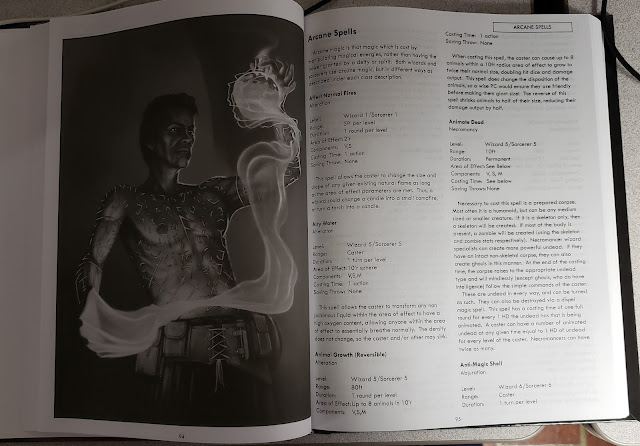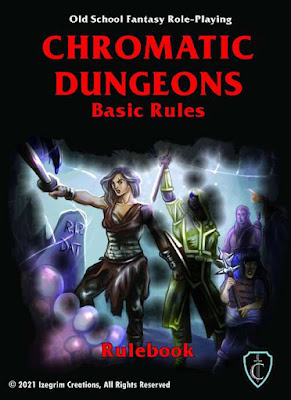Edited to add: Here are all the parts to this series: Part 1, Part 2, Part 3, and Part 4.
The craziness that is October is behind me now, time to settle in and read some books and do some reviews. I have been planning to do this one now for some time and this feels like the best time for me.
For the next few days I am going to review the new Old-School Game on the block, Chromatic Dungeons from Roderic Waibel and Izegrim Creations. Waibel ran a very successful Kickstarter for this over the Summer and the physical books and PDFs have been in my hands since the very start of Fall. I am happy to report I am very pleased with what I have received. I interviewed Waibel back when his Kickstarter was live so you can get an idea of the goals of Chromatic Dungeons. I'll refer back to that to see how well his stated goals were met for me.
Let me begin with noting that that there three distinct reviews I am doing here this week. The first covers the "Basic Rules" made up of Player's Book and a Monsters & Treasures book. The "advanced" or full game of Chromatic Dungeons will be tomorrow. Finally a zine-like product, The Gnoll Sage, will be after that.
Chromatic Dungeons, Basic Rules
Basic Rules, Player's Book. 86 pages, soft-cover, color cover art, black & white interior art.
Basic Rules, Monsters & Treasures. 58 pages, soft-cover, color cover art, black & white interior art.
For this review I am considering the two soft-cover Basic Rules books and PDFs.
The Basic Rules of Chromatic Dungeons consists of two books a Players Book and a Monsters & Treasures book. The material for the Game Masters is split between the two books. Players only need the Player's book, but the GM will need both. Considering the prices of the books this is not a problem.
The guiding principle for Chromatic Dungeons is to provide an old-school ruleset, say circa 1981, but still have some new school sensibilities. Because of this it does not make much sense to call Chromatic Dungeons a "retro clone." It is an old school game yes, but the rules inside are an interesting mix of old and new school mechanics. I will point these out as I move through the text but to put the major selling point up front, this is the game you are likely to have the most success with when introducing old school play to newer players. I will detail more (and a few more times) as we progress.
The Basic Rules are designed to introduce new players to the CD game. It has a lot in common with it's progenitor game, Dungeons & Dragons, in particular the 1981 Moldvay Basic set. It is written for people that have never played before. This is still a good thing since one of the goals I believe of this game IS to introduce new players to old-school gaming.
Basic Rules, Player's Book
We get an Introduction and Forward that helps explain the nature of this game, but also to set the stage for what we will see. The author wants to make it plain up front that this is an inclusive game and that everyone should feel welcome to it. This includes a brief overview of the game and a brief glosary of game terms to get everyone going.
Character Creation is first with the character concept and the rolling of ability scores. The method used here is 4d6, drop the lowest and arrange to suit your concept. This strikes a good balance between getting the character you want and old-school randomness. Want 3d6 in order? That game was already written and likely you already have it. After this you choose your Ancestry (and Heritage), Class and get equipment. Lets go into some detail here.
XP per Level is covered first. Each class uses the same XP value much like you see in 21st century D&D games (3rd Edition and beyond). This has a number of advantages of course. Multi-classing becomes easier and it helps keep level progression fairly even. Also it helps the intended audience, new gamers, become acclimated faster. (Editorial aside: I have taught many players whose first experiences were 3e, Pathfinder or 5e and they adapt to differing XP level charts fine; often with an occasional reminder that the thief is higher level because of it. But still this is easier.)
Ability Scores are the standard six we are all familiar with. Like the Moldvay Basic set the scores run 3-18 with simple modifiers they all share. Note. These mods are slightly different than what you might find in B/X, Labyrinth Lord, or Swords & Wizardry, so make sure you put them on your character sheet and don't go by memory. A simple ability check system that is compatible with, well, really all sorts of versions of D&D/Clones is presented.
Note in this version of the Chromatic Dragons game there are no "Saving Throws" but rather specialized ability checks. For example to "save" against some mind affecting magic you need to make a Wisdom check. This actually works rather well in my mind.
Ancestry and Heritage is the system used to replace the antiquated notions of "Race." Essentially this is a "Nature and Nurture" idea where Ancestry is your genetic or biologic make up and Heritage is how and under what conditions you were raised. For ancestry you can choose Dwarf, Elf, Halfling, and Human. Each has details common to members of the same Ancestry. Dwarves are short, live to 300 years or so, and also something called "solid build" which gives them the ability to reduce damage by blunt object by 1 point. Humans get to add 1 point to any ability score, elves don't need to sleep and so on. Heritages are how you you were raised. So this helps give players a bit of character creation control to that backstory in their minds. You choose two heritages and the list can easily expanded. For example you can be born a halfling and have all the benefits of the halfling ancestry, but maybe you lived in a a Dwarf community, so you have the heritages of "Crafting" and "Subterranean."
This is a great concept and one I would wholesale adopt for all my games in the future. It just works too well for me. But I do have a couple of nitpicks with how it is done here. First under Ancestry everyone gets a language of their ancestry. This is something I feel better goes under Heritage. And there are some heritages that are better suited for ancestry. For example my Halfling who grew up in the Dwarven community knows how to speak Halfling due to their Ancestry and has Infravision due their "Subterranean" heritage. I can see "Dark Adapted" working, or even the ability to detect sloping corridors; but infravision feels like something you should be born with and languages are something that are learned later. Again, a minor nitpick, but one I will adjust when playing.
Character Classes cover the three basic classes; Fighter, Rogues, and Wizard. Other 3-class games call these Warriors, Rogue (or Expert) and Adept, but the names in the book are more suited to this genre and make translations to the "Advanced" game easier. Each class get an ability bonus, much like you see in newer games. So fighters get a +1 bonus to Strength, Constitution, or Dexterity. This can be easily rationalized as training. Each class also gets a set of abilities. Note, the Rogue abilities are presented using the same system as all other ability checks. They get bonuses for particular abilities; same name as the thief abilities of other games. Each level they gain 6 points to improve their 9 abilities as they choose (reminds me of 2nd Ed AD&D's Rogues). I do rather like this, yes it is different from the multiple subsystems that was either the curse or the charm of old-school games (depending on your point of view) but it also makes for a speedier game. Wizards for this game cover wizards, magic-users and clerics. Another small nitpick, since there is the Advanced game, I would have called this class a Magic-user, and then when the classes are separated out in the Advanced game called the Magic-users Wizards. But again, this is minor.
Alignment is a basic, or rather Basic, affair of just Law, Neutrality and Chaos.
Equipment covers everything you can buy. I remember running some friend through the Keep on the Borderlands years decades ago and they spent the entire adventure shopping in the Keep and trying to get deals.
How to Play covers all the Basic rules starting with movement. Movement scale is closer to that of newer, 21st century forms on D&D. We also get good coverage on time, vision, stealth and more. Discussions on what you can do on your turn are detailed. At this point we have read a little about about combat, but not all of it. That comes up now with initiative. Here we are using a hybrid of Basic and 2nd Edition inspired initiative sequence. We also get Morale another Basic/2nd Ed hybrid, but based on a max score of 10 as opposed to 12 (Basic) or 20 (2nd Ed).
Armor class is Ascending, not Descending. This is good since it gets rid of the need for attack tables. Characters have an attack bonus and they roll vs. AC.
Experience Points are pretty much the same as seen in earlier versions of D&D. A bit on creating adventures is given and a sample adventure is provided.
Wizard Spells follow. Since there is only one spell casting class, all the spells to 5th level are here.
We end with a blank character sheet, Appendices of tables, sample characters and a combat quick guide.
Basic Rules, Monster & TreasureThis book is primarily for Game Masters.
The bulk (2/3) of the book is about monsters. It starts off with what the descriptions of the monsters mean, how to read the stat blocks and so on. The stat block is pretty similar to what is found in *D&D circa 1981, so reading or even adapting to other games is easy. While XP values are listed Treasure type is not.
There is a section on special monsters, such as having the abilities of a character type or class. As well as assigning numbers for ability checks for monsters. Something that will be easier in the "Advanced" version of the game.
The monsters are grouped by category rather than all alphabetical. The Categories are Beasts, Dinosaurs, Dragons, Elementals, Fey, Fiends, Giants, Humanoids, Lycanthropes, Monstrosities, and Undead. Nearly all the usual suspects are here.
Some monsters are given the alignment of "n/a." This is typically true of creatures that are too unintelligent for alignment such as dinosaurs, or humanoids that can be any alignment. I do think for creatures like beasts, dinosaurs and elementals that "neutral" would have been fine and for humanoids "any" would have worked. Fiends are all Chaotic and so are most of the Dragons, Giants, and Undead.
The Treasure section covers not only magical treasures as expected, but gives us an alternate treasure type system based on the monster's HD. So not dissimilar to 3e or 5e.
Both Books
Both books are filled with evocative old-school style art. Some of it from various stock art artists the Old-School community knows, but a good deal is original and new art. Much of it clearly enfluenced by 40 years of playing. The art goes beyond "Euro-centric" D&D art and variety of ethnicities, genders and peoples are represented.
Both books are really directed and written for people coming into the Old-School RPG scene anew. While there is a lot to enjoy here if you are an old Grog, and the art in this case is a particular treat, the audience that will get the most out of this are a generation younger. If you still have your original D&D books from the 1970s and 80s you will still find enjoyment here. Especially if you are like me and enjoy seeing the design choices of "D&D's Greatest Hits" here.
Both PDFs are fully bookmarked. Both books are fully OGC.
This game is a great game to introduce new players, new to RPGs or new to Old-School style games, to the ways of playing of the 1980s. Sure it is not exactly how we did it, but it is a great compromise between Old and New school. This game is also the perfect introduction to the "Advanced" game of Chromatic Dungeons. Finally, someone has made a "Basic" game that works great as an introduction to an "Advanced" game and one that works well enough on it's own. Yes, yes there is Old-School Essentials and Labyrinth Lord that have both Basic and Advanced options, but Chromatic Dungeons' Basic game is truly that, an introductory game, "Basic" and "basic" at the same time.
Tomorrow I'll talk about the full Advanced game.
































